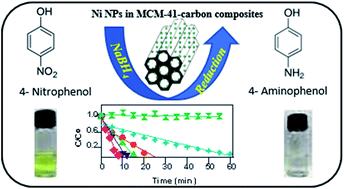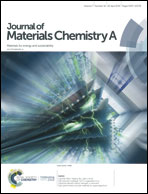Development of nickel-incorporated MCM-41–carbon composites and their application in nitrophenol reduction†
Abstract
MCM-41–carbon composites were obtained by soft-templating strategy by adding resorcinol and formaldehyde as carbon precursors during the synthesis of MCM-41. The synthesis of these composites was optimized until mesoporous MCM-41 domains remained highly ordered and the overall specific surface area and pore volume remained relatively high. The one-pot synthetic procedure was further extended to obtain the Ni-containing MCM-41–carbon composites using nickel nitrate as an additive. A homogeneous distribution of nickel nanoparticles in the composites was achieved by adding histidine to the reaction mixture, which was able to form a complex with nickel ion. Carbonization of organic components in the composites produced carbon that was responsible for in situ reduction of nickel(II) to metallic nickel (Ni0) at elevated temperatures, eliminating the post-synthesis reduction step carried out in the presence of hydrogen gas or other reducing agent. The resulting composites showed enhanced catalytic activity toward nitrophenol reduction obeying the zero-order kinetics. Three unique features of the resulting composites, namely mesoporous channels of MCM-41, carbon-induced in situ reduction of Ni ions to metallic Ni nanoparticles, and abundance of highly active Ni sites due to high dispersion of Ni0, make this strategy applicable for the synthesis of other transition metal-based catalysts. XRD and STEM analyses revealed a homogeneous distribution of nickel nanoparticles in the composites without significant distortion of their ordered mesoporosity.

- This article is part of the themed collection: 2019 Journal of Materials Chemistry A HOT Papers


 Please wait while we load your content...
Please wait while we load your content...